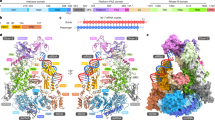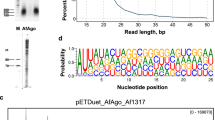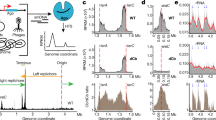Abstract
The discovery of RNA-mediated gene-silencing pathways, including RNA interference1,2,3, highlights a fundamental role of short RNAs in eukaryotic gene regulation4,5,6,7,8,9,10 and antiviral defence11,12. Members of the Dicer and Argonaute protein families are essential components of these RNA-silencing pathways13,14,15,16,17,18,19. Notably, these two families possess an evolutionarily conserved PAZ (Piwi/Argonaute/Zwille) domain whose biochemical function is unknown. Here we report the nuclear magnetic resonance solution structure of the PAZ domain from Drosophila melanogaster Argonaute 1 (Ago1). The structure consists of a left-handed, six-stranded β-barrel capped at one end by two α-helices and wrapped on one side by a distinctive appendage, which comprises a long β-hairpin and a short α-helix. Using structural and biochemical analyses, we demonstrate that the PAZ domain binds a 5-nucleotide RNA with 1:1 stoichiometry. We map the RNA-binding surface to the open face of the β-barrel, which contains amino acids conserved within the PAZ domain family, and we define the 5′-to-3′ orientation of single-stranded RNA bound within that site. Furthermore, we show that PAZ domains from different human Argonaute proteins also bind RNA, establishing a conserved function for this domain.
This is a preview of subscription content, access via your institution
Access options
Subscribe to this journal
Receive 51 print issues and online access
$199.00 per year
only $3.90 per issue
Buy this article
- Purchase on Springer Link
- Instant access to full article PDF
Prices may be subject to local taxes which are calculated during checkout




Similar content being viewed by others
References
Fire, A. et al. Potent and specific genetic interference by double-stranded RNA in Caenorhabditis elegans. Nature 391, 806–811 (1998)
Dykxhoorn, D. M., Novina, C. D. & Sharp, P. A. Killing the messenger: short RNAs that silence gene expression. Nature Rev. Mol. Cell Biol. 4, 457–467 (2003)
Hannon, G. J. RNA interference. Nature 418, 244–251 (2002)
Hutvagner, G. et al. A cellular function for the RNA-interference enzyme Dicer in the maturation of the let-7 small temporal RNA. Science 293, 834–838 (2001)
Grishok, A. et al. Genes and mechanisms related to RNA interference regulate expression of the small temporal RNAs that control C. elegans developmental timing. Cell 106, 23–34 (2001)
Lee, R. C., Feinbaum, R. L. & Ambros, V. The C. elegans heterochronic gene lin-4 encodes small RNAs with antisense complementarity to lin-14. Cell 75, 843–854 (1993)
Volpe, T. A. et al. Regulation of heterochromatic silencing and histone H3 lysine-9 methylation by RNAi. Science 297, 1833–1837 (2002)
Hall, I. M. et al. Establishment and maintenance of a heterochromatin domain. Science 297, 2232–2237 (2002)
Mochizuki, K., Fine, N. A., Fujisawa, T. & Gorovsky, M. A. Analysis of a piwi-related gene implicates small RNAs in genome rearrangement in tetrahymena. Cell 110, 689–699 (2002)
Schramke, V. & Allshire, R. Hairpin RNAs and retrotransposon LTRs effect RNAi and chromatin-based gene silencing. Science 301, 1069–1074 (2003)
Ratcliff, F., Harrison, B. D. & Baulcombe, D. C. A similarity between viral defense and gene silencing in plants. Science 276, 1558–1560 (1997)
Waterhouse, P. M., Wang, M. B. & Lough, T. Gene silencing as an adaptive defence against viruses. Nature 411, 834–842 (2001)
Zamore, P. D., Tuschl, T., Sharp, P. A. & Bartel, D. P. RNAi: double-stranded RNA directs the ATP-dependent cleavage of mRNA at 21 to 23 nucleotide intervals. Cell 101, 25–33 (2000)
Bernstein, E., Caudy, A. A., Hammond, S. M. & Hannon, G. J. Role for a bidentate ribonuclease in the initiation step of RNA interference. Nature 409, 363–366 (2001)
Knight, S. W. & Bass, B. L. A role for the RNase III enzyme DCR-1 in RNA interference and germ line development in Caenorhabditis elegans. Science 293, 2269–2271 (2001)
Hammond, S. M., Bernstein, E., Beach, D. & Hannon, G. J. An RNA-directed nuclease mediates post-transcriptional gene silencing in Drosophila cells. Nature 404, 293–296 (2000)
Hammond, S. M., Boettcher, S., Caudy, A. A., Kobayashi, R. & Hannon, G. J. Argonaute2, a link between genetic and biochemical analyses of RNAi. Science 293, 1146–1150 (2001)
Tabara, H. et al. The rde-1 gene, RNA interference, and transposon silencing in C. elegans. Cell 99, 123–132 (1999)
Williams, R. W. & Rubin, G. M. ARGONAUTE1 is required for efficient RNA interference in Drosophila embryos. Proc. Natl Acad. Sci. USA 99, 6889–6894 (2002)
Cerutti, L., Mian, N. & Bateman, A. Domains in gene silencing and cell differentiation proteins: the novel PAZ domain and redefinition of the Piwi domain. Trends Biochem. Sci. 25, 481–482 (2000)
Kambach, C. et al. Crystal structures of two Sm protein complexes and their implications for the assembly of the spliceosomal snRNPs. Cell 96, 375–387 (1999)
Lau, N. C., Lim, L. P., Weinstein, E. G. & Bartel, D. P. An abundant class of tiny RNAs with probable regulatory roles in Caenorhabditis elegans. Science 294, 858–862 (2001)
Reinhart, B. J. et al. The 21-nucleotide let-7 RNA regulates developmental timing in Caenorhabditis elegans. Nature 403, 901–906 (2000)
Nykanen, A., Haley, B. & Zamore, P. D. ATP requirements and small interfering RNA structure in the RNA interference pathway. Cell 107, 309–321 (2001)
Elbashir, S. M., Martinez, J., Patkaniowska, A., Lendeckel, W. & Tuschl, T. Functional anatomy of siRNAs for mediating efficient RNAi in Drosophila melanogaster embryo lysate. EMBO J. 20, 6877–6888 (2001)
Schwarz, D. S., Hutvagner, G., Haley, B. & Zamore, P. D. Evidence that siRNAs function as guides, not primers, in the Drosophila and human RNAi pathways. Mol. Cell 10, 537–548 (2002)
Martinez, J., Patkaniowska, A., Urlaub, H., Luhrmann, R. & Tuschl, T. Single-stranded antisense siRNAs guide target RNA cleavage in RNAi. Cell 110, 563–574 (2002)
Lingel, A., Simon, B., Izaurralde, E. & Sattler, M. Structure and nucleic-acid binding of the Drosophila Argonaute 2 PAZ domain. Nature advance online publication, 16 November 2003 (doi:10.1038/nature02123)
Dostie, J., Mourelatos, Z., Yang, M., Sharma, A. & Dreyfuss, G. Numerous microRNPs in neuronal cells containing novel microRNAs. RNA 9, 180–186 (2003)
Brunger, A. T. X-PLOR Version 3.1: A System for X-Ray Crystallography and NMR (Yale Univ. Press, New Haven, Connecticut, 1993)
Nilges, M. & O'Donoghue, S. Ambiguous NOEs and automated NOE assignment. Prog. NMR Spectrosc. 32, 107–139 (1998)
Acknowledgements
We thank R. W. Williams for providing a D. melanogaster Ago1 expressed sequenced tag clone, T. Tuschl for complementary DNAs encoding human Argonaute proteins, and T. A. Edwards for discussions. K.S.Y. is a recipient of a National Institutes of Health (NIH) predoctoral training grant fellowship. M.-M.Z. is supported by NIH grants, and is a member of the New York Structural Biology Center.
Author information
Authors and Affiliations
Corresponding author
Ethics declarations
Competing interests
The authors declare that they have no competing financial interests.
Rights and permissions
About this article
Cite this article
Yan, K., Yan, S., Farooq, A. et al. Structure and conserved RNA binding of the PAZ domain. Nature 426, 469–474 (2003). https://doi.org/10.1038/nature02129
Received:
Accepted:
Published:
Issue Date:
DOI: https://doi.org/10.1038/nature02129
This article is cited by
-
ARGONAUTE 1: a node coordinating plant disease resistance with growth and development
Phytopathology Research (2023)
-
Genome-wide investigation of the WRKY transcription factor gene family in weeping forsythia: expression profile and cold and drought stress responses
Genetica (2023)
-
Unlocking the potential of RNAi as a therapeutic strategy against infectious viruses: an in-silico study
Chemical Papers (2023)
-
PiRNA in Cardiovascular Disease: Focus on Cardiac Remodeling and Cardiac Protection
Journal of Cardiovascular Translational Research (2023)
-
Genome-wide identification of DCL, AGO, and RDR gene families in wheat (Triticum aestivum L.) and their expression analysis in response to heat stress
Physiology and Molecular Biology of Plants (2023)
Comments
By submitting a comment you agree to abide by our Terms and Community Guidelines. If you find something abusive or that does not comply with our terms or guidelines please flag it as inappropriate.



